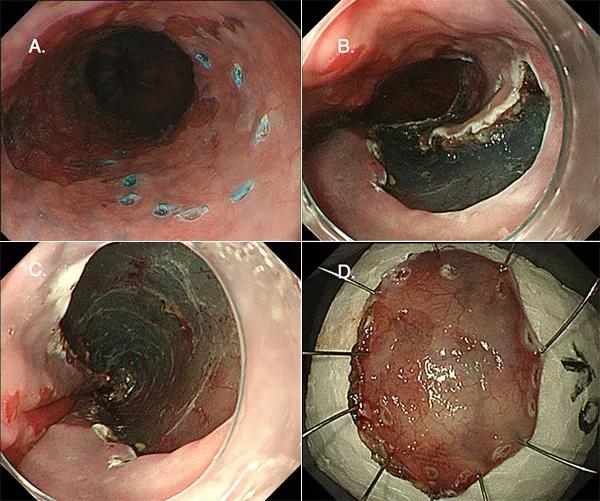Endoscopic submucosal dissection is gaining popularity

Endoscopic submucosal dissection (ESD), a technique developed in Japan, has made its way to the United States, where it is offering a valuable alternative to the risks and complications associated with traditional surgical removal of early stage gastrointestinal tumors.
Cleveland Clinic is a non-profit academic medical center. Advertising on our site helps support our mission. We do not endorse non-Cleveland Clinic products or services. Policy
ESD is performed by first introducing an endoscope through the mouth of the patient and into the esophagus or stomach. Through the endoscopy devices, experts can then dissect and remove the cancer from the gastrointestinal wall and take it out the patient’s mouth. This allows for complete removal of the cancer while allowing the patient to keep their esophagus/stomach and avoid traditional surgery. This same technique can be used to remove tumors of the colon through a colonoscope.
“In essence, ESD is operating through an endoscope to precisely remove early tumors, allowing the patient to keep their native organ, and avoid the significant morbidity and quality of life impairment associated with radical surgical resections,” says Amit Bhatt, MD, a gastroenterologist at Cleveland Clinic, who recently published a paper with his colleagues on indications and techniques for ESD in the American Journal of Gastroenterology.
Traditional endoscopic mucosal resection has to remove tumors greater than 2 cm in pieces, meaning small amounts of tumors could be left behind, and it is hard to assess if the tumor is completely removed.

“In ESD, as the tumor is removed in one-piece, similar to a surgical resection, the pathologist can make a very accurate assessment of whether the entire cancer has been removed,” Dr. Bhatt says.
Thanks to grants from the American Society for Gastrointestinal Endoscopy and American College of Gastroenterology, Dr. Bhatt has completed extensive ESD training in Japan, where the technique was pioneered to address the country’s high incidence of gastric cancers. More than 50 percent of gastric cancers are caught early in Japan due to widespread screening programs. The country’s focus of improving treatment of early gastric cancer spurred the development of ESD. After ESD was proven to be a highly effective treatment option for gastric cancer, the technique was successfully extended to esophageal and colonic tumors.
Although the incidence of lung, breast and prostate cancers exceeds that of gastrointestinal cancers in the United States, gastrointestinal cancers still carry a significant burden here.
“Mirroring the increase in obesity and gastroesophageal reflux disease, the incidence of esophageal adenocarcinoma has rapidly risen in the Western world. Through increased awareness and screening of at-risk patients, we expect the number of patients diagnosed with early esophageal cancer is going to get larger,” Dr. Bhatt says. “While esophagectomy is effective from a curative standpoint because the esophagus lies within the chest cavity, an esophagectomy can be a morbid procedure and many patients may not be ideal candidates for the surgery.”
Dr. Bhatt and his colleagues recently performed a curative ESD resection of a 4-cm cancer at the gastroesophageal junction in an older male who had recently undergone coronary artery bypass graft surgery and was not a candidate for esophagectomy.
The major difference between surgery and ESD is that “we can only resect the primary tumor itself with ESD,” he notes. “We can’t resect any lymph nodes. Part of understanding indications for this technique is knowing when a tumor has grown to the size or aggressiveness in which there is a chance that it has spread to the lymph nodes.”
Japanese data on thousands of specimens has enabled the characterization of patients whose risk of lymph node spread is extremely low and are candidates for ESD resection – data that Dr. Bhatt cites in his recent publication.
“For example, for a well-differentiated superficial gastric tumor without an ulcer, we can resect the tumor regardless of its size,” he explains. “However, if the tumor is greater than 3 cm and invades deeper into the submucosa, then surgery is probably the best option.”
Dr. Bhatt stresses the importance of a multidisciplinary evaluation involving a gastroenterologist, surgeon and oncologist to determine the best treatment for a patient with an early lesion who might be a candidate for ESD. “Many of these patients can have their tumors resected with endoscopy and have the same long-term outcomes as surgical resection,” he says. “The procedure is less invasive, cost-effective and preserves the quality of life.”
He notes that ESD is a technically difficult procedure to learn and perform well. “You want to make sure the person doing it is adequately trained, and has a track record of success with it.”

An underdiagnosed condition in patients with cancer

Study demonstrates superior visualization of occult primary lesions

New device offers greater tumor control for malignant liver lesions

Cleveland Clinic researchers discover what drives – and what may halt – virus-induced cancer

First-ever U.S. population-level retrospective analysis reveals many patients with systemic mastocytosis need faster intervention

New program provides prehabilitation and rehabilitation services to help patients with cancer maintain and regain function

First-of-its-kind research investigates the viability of standard screening to reduce the burden of late-stage cancer diagnoses

Global R&D efforts expanding first-line and relapse therapy options for patients